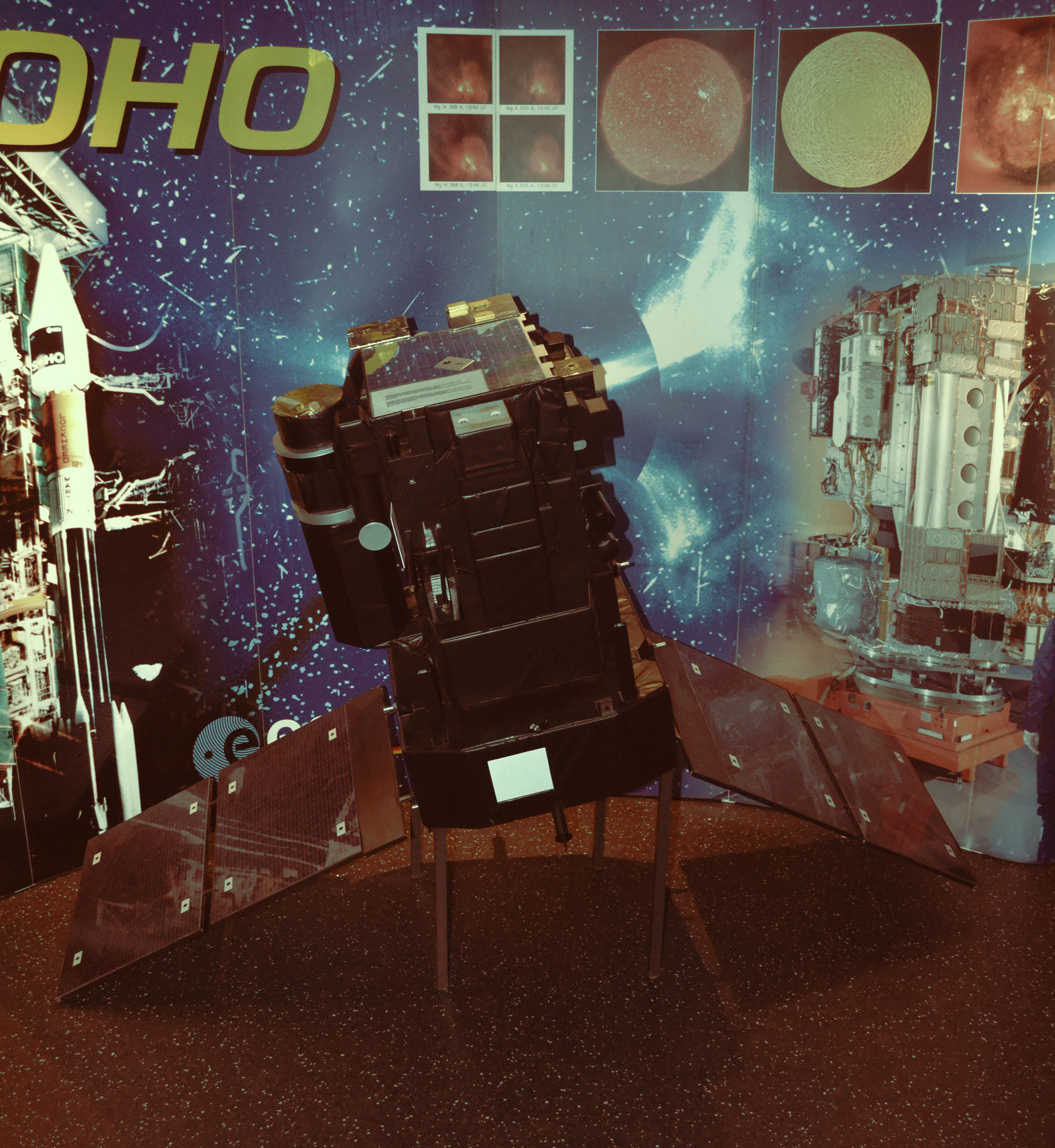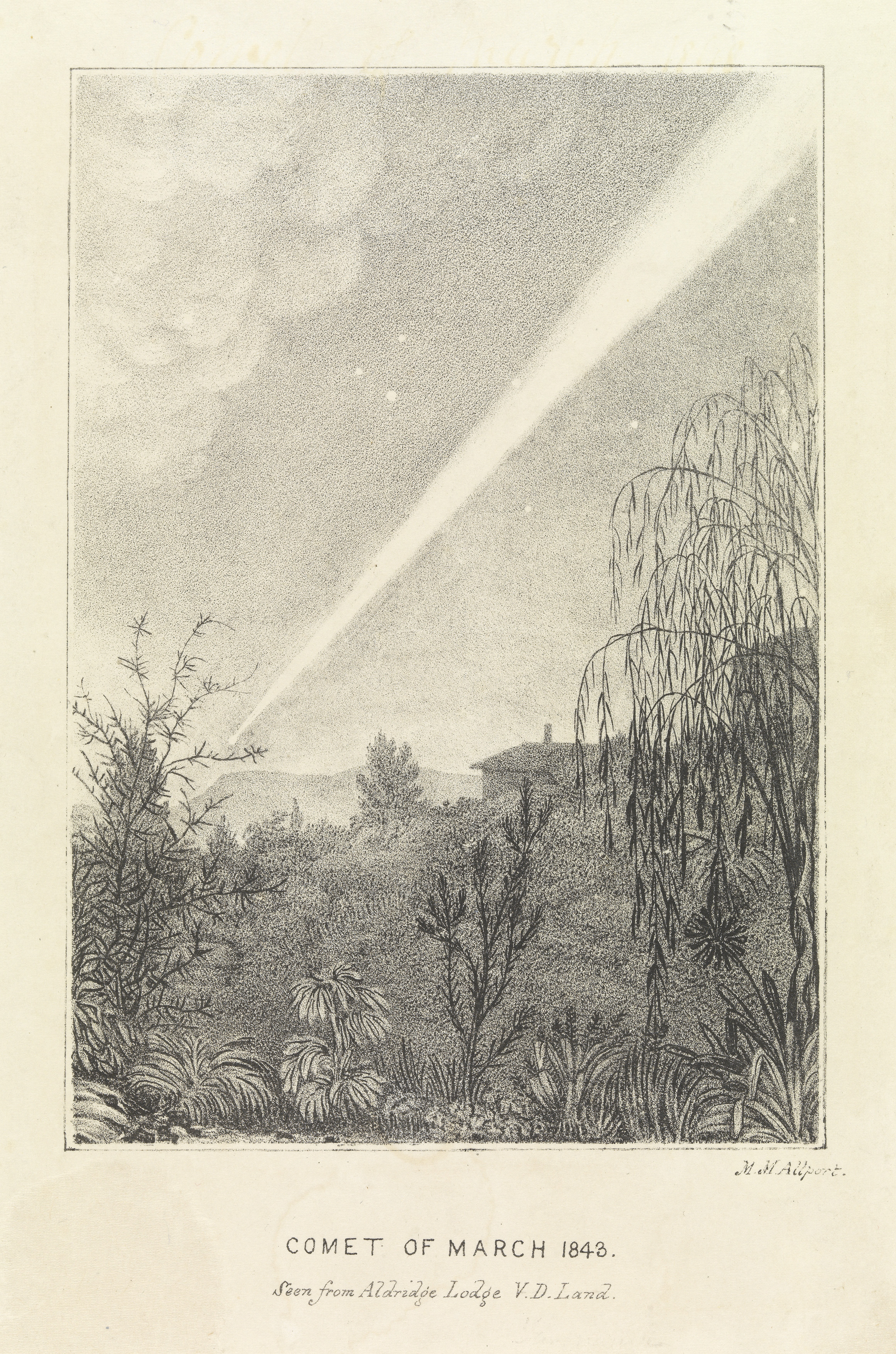|
96P-family
The 96P sungrazer family is a small group of sungrazing comets, originating from the comet 96P/Machholz. It is only observed by LASCO corongraphs aboard SOHO (Solar and Heliospheric Observatory) probe. It contains three subgroups: Marsden, Kracht and Kracht II. 96P type is the rarest among all objects recorded by SOHO: just 3% of all belong to this group. The 5000th comet observed by this probe belongs to the Marsden group, and was discovered on 25 March 2024. Source and discovery It is suggested that this group comes from fragments detached from the Macholz comet about 800 to 1,200 years ago. The orbit is very similar to the parent body with slightly different gravitational contacts with Jupiter and lower perihelion distance as well as inclination Orbital inclination measures the tilt of an object's orbit around a celestial body. It is expressed as the angle between a reference plane and the orbital plane or axis of direction of the orbiting object. For a satellite ... [...More Info...] [...Related Items...] OR: [Wikipedia] [Google] [Baidu] |
96P/Machholz
Comet 96P/Machholz or 96P/Machholz 1 is a Short-period comet, short-period sungrazing comet discovered on May 12, 1986, by Amateur astronomy, amateur astronomer Donald Machholz on Loma Prieta peak, in central California using binoculars. On June 6, 1986, 96P/Machholz passed from the Earth. 96P/Machholz last came to perihelion on January 31, 2023. The comet has an estimated diameter of around . This comet is a parent body of 96P-family sungrazing comets. 96P/Machholz is unusual among comets in several respects. Other than small SOHO comets, its highly Orbital eccentricity, eccentric 5.29 year orbit has the smallest perihelion distance known among numbered/regular short-period comets, bringing it considerably closer to the Sun than the orbit of Mercury (planet), Mercury. It is also the only known short-period comet with both high orbital inclination and high eccentricity. In 2007, 96P/Machholz was found to be both carbon-depleted and cyanogen-depleted, a chemical composition nea ... [...More Info...] [...Related Items...] OR: [Wikipedia] [Google] [Baidu] |
Large Angle And Spectrometric Coronagraph
The Large Angle and Spectrometric Coronagraph (LASCO) on board the Solar and Heliospheric Observatory satellite (SOHO) consists of three solar coronagraphs with nested fields of view: * C1 - a Fabry–Pérot interferometer coronagraph imaging from 1.1 to 3 solar radii, non-functional since the 24 June 1998 SOHO Mission Interruption * C2 - a white light coronagraph imaging from 1.5 to 6 solar radii (orange) * C3 - a white light coronagraph imaging from 3.7 to 30 solar radii (blue) The first principal investigator was Dr. Guenter Brueckner. These coronagraphs monitor the solar corona by using an optical system to create, in effect, an artificial solar eclipse. The white light coronagraphs C2 and C3 produce images of the corona over much of the visible spectrum, while the C1 interferometer produces images of the corona in a number of very narrow visible wavelength bands. Shutter speed LASCO C3, the clear coronagraph picture, has a shutter time of about 19 seconds. LASCO C2, the oran ... [...More Info...] [...Related Items...] OR: [Wikipedia] [Google] [Baidu] |
Solar And Heliospheric Observatory
The Solar and Heliospheric Observatory (SOHO) is a European Space Agency (ESA) spacecraft built by a European industrial consortium led by Matra Marconi Space (now Airbus Defence and Space) that was launched on a Lockheed Martin Atlas IIAS launch vehicle on 2 December 1995, to study the Sun. It has also discovered more than 5,000 comets. It began normal operations in May 1996. It is a joint project between the European Space Agency (ESA) and NASA. SOHO was part of the International Solar Terrestrial Physics Program (ISTP). Originally planned as a two-year mission, SOHO continues to operate after 29 years in space; the mission has been extended until the end of 2025, subject to review and confirmation by ESA's Science Programme Committee. In addition to its scientific mission, it is a main source of near-real-time solar data for space weather prediction. Along with Aditya-L1, Wind, Advanced Composition Explorer (ACE), and Deep Space Climate Observatory (DSCOVR), SOHO is one ... [...More Info...] [...Related Items...] OR: [Wikipedia] [Google] [Baidu] |
Jupiter
Jupiter is the fifth planet from the Sun and the List of Solar System objects by size, largest in the Solar System. It is a gas giant with a Jupiter mass, mass more than 2.5 times that of all the other planets in the Solar System combined and slightly less than one-thousandth the mass of the Sun. Its diameter is 11 times that of Earth and a tenth that of the Sun. Jupiter orbits the Sun at a distance of , with an orbital period of . It is the List of brightest natural objects in the sky, third-brightest natural object in the Earth's night sky, after the Moon and Venus, and has been observed since prehistoric times. Its name derives from that of Jupiter (god), Jupiter, the chief deity of ancient Roman religion. Jupiter was the first of the Sun's planets to form, and its inward migration during the primordial phase of the Solar System affected much of the formation history of the other planets. Jupiter's atmosphere consists of 76% hydrogen and 24% helium by mass, with a denser ... [...More Info...] [...Related Items...] OR: [Wikipedia] [Google] [Baidu] |
Apsis
An apsis (; ) is the farthest or nearest point in the orbit of a planetary body about its primary body. The line of apsides (also called apse line, or major axis of the orbit) is the line connecting the two extreme values. Apsides pertaining to orbits around different bodies have distinct names to differentiate themselves from other apsides. Apsides pertaining to geocentric orbits, orbits around the Earth, are at the farthest point called the ''apogee'', and at the nearest point the ''perigee'', like with orbits of satellites and the Moon around Earth. Apsides pertaining to orbits around the Sun are named ''aphelion'' for the farthest and ''perihelion'' for the nearest point in a heliocentric orbit. Earth's two apsides are the farthest point, ''aphelion'', and the nearest point, ''perihelion'', of its orbit around the host Sun. The terms ''aphelion'' and ''perihelion'' apply in the same way to the orbits of Jupiter and the other planets, the comets, and the asteroids of t ... [...More Info...] [...Related Items...] OR: [Wikipedia] [Google] [Baidu] |
Orbital Inclination
Orbital inclination measures the tilt of an object's orbit around a celestial body. It is expressed as the angle between a reference plane and the orbital plane or axis of direction of the orbiting object. For a satellite orbiting the Earth directly above the Equator, the plane of the satellite's orbit is the same as the Earth's equatorial plane, and the satellite's orbital inclination is 0°. The general case for a circular orbit is that it is tilted, spending half an orbit over the northern hemisphere and half over the southern. If the orbit swung between 20° north latitude and 20° south latitude, then its orbital inclination would be 20°. Orbits The inclination is one of the six orbital elements describing the shape and orientation of a celestial orbit. It is the angle between the orbital plane and the plane of reference, normally stated in degrees. For a satellite orbiting a planet, the plane of reference is usually the plane containing the planet's equator. For pla ... [...More Info...] [...Related Items...] OR: [Wikipedia] [Google] [Baidu] |
Brian G
Brian Griffin is a fictional character from the American animated sitcom ''Family Guy''. He is one of the main characters of the series and a member of the Griffin family. Created, designed, and voiced by Seth MacFarlane, he is an anthropomorphic white Labrador Retriever, labrador retriever who is the best friend of both Peter Griffin, Peter and Stewie Griffin, Stewie Griffin and comic Foil (narrative), foil with the ability to speak, sing, drive, and stand on two legs. Brian first appeared on television, along with the rest of the Griffin family, in the series premiere "Death Has a Shadow" on January 31, 1999. MacFarlane was asked to pitch a pilot to the Fox Broadcasting Company, based on The Life of Larry and Larry & Steve, ''The Life of Larry'' and ''Larry & Steve'', two shorts made by MacFarlane featuring a middle-aged character named Larry and an intellectual dog, Steve. These two characters were redesigned and renamed Peter and Brian, but they retained similar voices a ... [...More Info...] [...Related Items...] OR: [Wikipedia] [Google] [Baidu] |
Kreutz Sungrazer
The Kreutz sungrazers ( ) are a family of sungrazing comets, characterized by orbits taking them extremely close to the Sun at perihelion. At the far extreme of their orbits, aphelion, Kreutz sungrazers can be a hundred times farther from the Sun than the Earth is, while their distance of closest approach can be less than twice the Sun's radius. They are believed to be fragments of one large comet that broke up several centuries ago and are named for German astronomer Heinrich Kreutz, who first demonstrated that they were related. These sungrazers make their way from the distant outer Solar System to the inner Solar System, to their perihelion point near the Sun, and then leave the inner Solar System in their return trip to their aphelion. Several members of the Kreutz family have become great comets, occasionally visible near the Sun in the daytime sky. The most recent of these was Comet Ikeya–Seki in 1965, which may have been one of the brightest comets in the last millenniu ... [...More Info...] [...Related Items...] OR: [Wikipedia] [Google] [Baidu] |
Astronomy
Astronomy is a natural science that studies celestial objects and the phenomena that occur in the cosmos. It uses mathematics, physics, and chemistry in order to explain their origin and their overall evolution. Objects of interest include planets, natural satellite, moons, stars, nebulae, galaxy, galaxies, meteoroids, asteroids, and comets. Relevant phenomena include supernova explosions, gamma ray bursts, quasars, blazars, pulsars, and cosmic microwave background radiation. More generally, astronomy studies everything that originates beyond atmosphere of Earth, Earth's atmosphere. Cosmology is a branch of astronomy that studies the universe as a whole. Astronomy is one of the oldest natural sciences. The early civilizations in recorded history made methodical observations of the night sky. These include the Egyptian astronomy, Egyptians, Babylonian astronomy, Babylonians, Greek astronomy, Greeks, Indian astronomy, Indians, Chinese astronomy, Chinese, Maya civilization, M ... [...More Info...] [...Related Items...] OR: [Wikipedia] [Google] [Baidu] |
Cometary Objects
A comet is an icy, small Solar System body that warms and begins to release gases when passing close to the Sun, a process called outgassing. This produces an extended, gravitationally unbound atmosphere or coma surrounding the nucleus, and sometimes a tail of gas and dust gas blown out from the coma. These phenomena are due to the effects of solar radiation and the outstreaming solar wind plasma acting upon the nucleus of the comet. Comet nuclei range from a few hundred meters to tens of kilometers across and are composed of loose collections of ice, dust, and small rocky particles. The coma may be up to 15 times Earth's diameter, while the tail may stretch beyond one astronomical unit. If sufficiently close and bright, a comet may be seen from Earth without the aid of a telescope and can subtend an arc of up to 30° (60 Moons) across the sky. Comets have been observed and recorded since ancient times by many cultures and religions. Comets usually have highly eccentric ellip ... [...More Info...] [...Related Items...] OR: [Wikipedia] [Google] [Baidu] |







